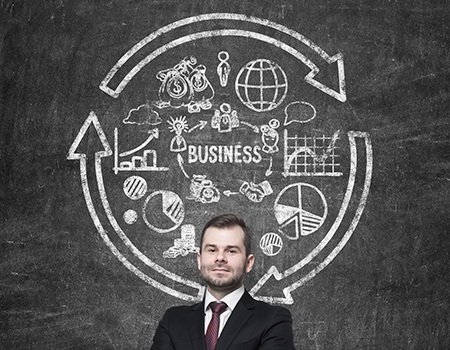What Causes the Business Cycle?

The business cycle is something taught in every Economics 101 class. It is used by businesses and investment professionals to inform their decisions. The exact cause of the business cycle is still debated among economists; however, we do know that it is primarily driven by consumer psychology, as well as supply and demand. Below, let’s look at each of the four phases of the business cycle and what factors lead to the economy moving from one phase to the next.
Expansion – This is typically the longest phase of the cycle and is likely what most people think of as a normal economy. Growth in demand slightly outpaces growth in supply leading to a normal amount of price inflation, as well as asset and wage growth. Consumers are happy and confident which leads to increased spending and continued growth in demand. As markets saturate, either supply or demand begins to meaningfully outpace the other, leading to the next phase, which is late expansion.
Late Expansion – One of two things typically begins to happen in late expansion. One, demand greatly outpaces supply leading to exuberance in investment and pricing. This can cause asset bubbles, which eventually burst prior to a recession (think real estate market in 2008). Two, slowing growth due to oversaturation of markets leads to vulnerability to some external event that may cause a recession (like our recent pandemic).
Recession – Recessions are one of the shortest phases of the cycle, but their effects on the economy and its participants are very profound. In the case of an asset bubble or external shock, consumers lose wealth when the downturn begins. Reduced spending leads to weakening company financials which can cause businesses to cut hiring or reduce pay. Finally, lower pay for consumers leads to an even further reduction in spending. Once the economy reaches its bottom and things begin to stabilize, there is a transition to the final phase.
Recovery/Early Expansion – As consumers return to work, company profits begin to stabilize and overall positive sentiment increases, ushering in the recovery/early expansion phase. When investors, consumers and companies regain confidence, spending and investing increase. This change leads to rapid expansion as funds that were once held back as reserves are deployed again. The pent-up demand is then met with additional supply, and the economy begins to settle back to its long-term average growth rate of 2-3% annually. At this point, we have closed the cycle and are back into the expansion phase.
Each full cycle looks a little different from the last one, but the general driving factors remain the same. The global economy is inherently complex and predicting when and how each phase will happen is difficult, if not impossible. However, awareness of the different phases can serve as guidance on what to expect in the future, as well as providing historical evidence that the rough times are typically short, and the good times last much longer.
You should not assume that any information provided serves as the receipt of, or as a substitute for, personalized investment advice from Waverly Advisors. This information should be used as a reference only. Talk to your Waverly Advisors, or a professional advisor of your choosing, for guidance specific to your situation.
